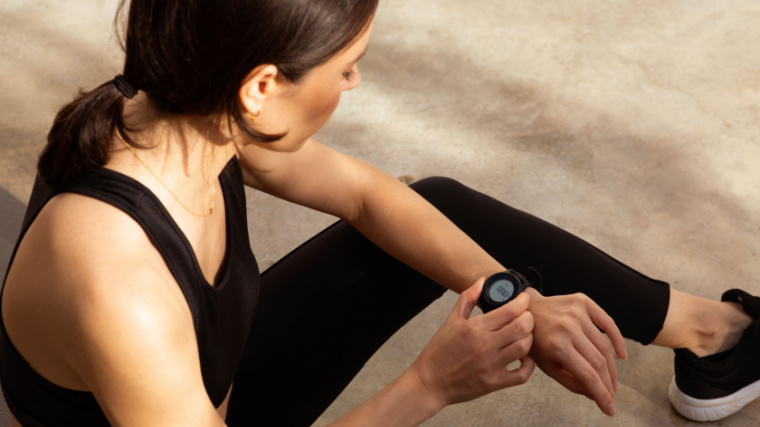If you’ve got a fitness tracker, the number of steps you need to hit to close those rings is often a crisp, clean 10,000. Even if you don’t wear a tracker on your wrist, plenty of smartphones are preprogrammed with an internal tracker with a preset goal of — you guessed it — 10,000 steps a day.

But do you actually need 10,000 steps a day to improve or maintain your cardio and overall health? We’ll break down the history and update you on the latest, science-based recommendations. Lace up those walking shoes, and let’s get into it.
Editor’s Note: The content on BarBend is meant to be informative in nature, but it should not be taken as medical advice. When starting a new training regimen and/or diet, it is always a good idea to consult with a trusted medical professional. We are not a medical resource. The opinions and articles on this site are not intended for use as diagnosis, prevention, and/or treatment of health problems. They are not substitutes for consulting a qualified medical professional.
First… Why 10,000 Steps?
Getting 10,000 steps a day seems to be the dominant advice in fitness and casual circles alike. Everything from your smartphone and fitness tracker to the wellness challenges in the office encourages it. You may already be aiming to hit that benchmark.
Why 10,000, exactly? It all started after the 1965 Tokyo Olympics.
[Read More: 10 Science-Backed Benefits of Walking for Strength Athletes]
A Japanese company, Yamasa, created a pedometer called manpo-kei, which translates to “10,000 step meter.” The 10,000-step goal was used as a marketing campaign for the step counter and a public health initiative. Dr. Yoshiro Hatano believed getting 10,000 daily steps would help Japanese people lower their risk of heart disease. (1)
How Many Steps Do You Actually Need?
Since 1965, many step counters and fitness trackers have passed through the market. Perhaps 10,000 remains a memorable and round number for marketing campaigns. Regardless of what’s catchy, several studies set out to find the ideal number of steps you actually need.
Remember that “step count” is largely about aerobic activity level. This means that if you’re unable to walk, there are other ways to fulfill your physical activity recommendations — steps aren’t the only way.
The Centers for Disease Control and Prevention (CDC) notes the following Physical Activity Guidelines for Americans from the U.S. Department of Health and Human Services: (2)(3)
- 150 minutes of moderate-intensity aerobic physical activity, 75 minutes of vigorous-intensity exercise, or a combination of both per week.
- Performing muscle-strengthening exercises, like resistance training, on two or more days per week.
According to the CDC, only half of Americans reach the minimum recommendation for minutes of exercise. According to the Mayo Clinic, Americans currently get 3,000 to 4,000 daily steps. In 2010, Americans took 5,900 to 6,900 daily steps, meaning we now get fewer steps. Walking — for folks who can walk — is a generally accessible way to reach these recommendations. (4)(5)(6)
[Read More: How to Level-Up Your Daily Movement, According to Dr. Kelly Starrett]
To meet the Physical Activity Guidelines through steps alone, you’ll need to do some brisk walking to get your heart rate up. Here’s how the numbers break down. (6)
- Aim for 8,900 to 9,900 daily steps, five days a week. At least 3,000 steps should be brisk walking for 30 minutes to qualify as moderate-intensity exercise.
- Alternatively, aim for 9,150 to 10,150 daily steps, three days a week. Let 3,250 of your daily steps be in 10-minute increments at a higher heart rate for vigorous-intensity exercise.
Now, 10,000 steps (or about five miles) is a hefty amount of steps each day. It’s certainly not impossible (more on that below). But don’t panic if you can’t hit that number. Research says you don’t have to quite get that many in.
Sedentary people would benefit from getting any number of steps more than they currently get — but let’s break down some recent research trying to nail down the magic number.
- A few studies have been published in the Journal of the American Medical Association (JAMA). A 2019 study investigated the link between all-cause mortality and daily steps in older women at an average age of 72. Those who took 4,400 steps daily had a lower mortality risk than those who took 2,700. Benefits increased to 7,500 steps daily; any higher didn’t make a difference. (7)
- A study on younger American adults (over 40 but at an average age of 56) was published in JAMA in 2020. It found that taking 8,000 daily steps was associated with a lower risk of all-cause mortality than taking 4,000 daily steps. (8)
- A new study on 78,500 British adults aged 40 to 79 (average 61) was published in JAMA in 2022. It found no minimum step count, and all steps up to 10,000 were associated with a lower risk of all-cause mortality and cardiovascular diseases. (9)
- A 2023 meta-analysis found that taking at least 2,600 to 2,800 daily steps lowered mortality risk and cardiovascular diseases. Health benefits increased as steps increased to 7,200 and 8,800, then leveled off. (10)
- A 2022 meta-analysis split step benefits by age group. Health benefits for older adults over 60 level off after 6,000 to 8,000 daily steps. For adults under 60, benefits increase until 8,000 to 10,000 steps. (11)
No study has shown that taking more than 10,000 daily steps further decreases the risk of cardiovascular disease and mortality. For older adults, it seems like 7,000 is a good maximum to aim for. Younger adults can benefit from at least 8,000 daily steps.
It’s important to note that for sedentary people, or anyone who can’t reach these higher numbers, even 2,000 steps a day has been beneficial.
The Benefits of Walking 10,000 Steps (or Just More Than You Are Now)
Walking is often an easy way to get more movement. Moving more is part of a healthy lifestyle and boosts overall health. Whether you’re a stickler for numbers or just want to walk more than you do now, here are the top health benefits of increasing your step count.
Protects Heart Health
Regular bodyweight cardio exercise — any physical activity that raises your heart rate that you perform rhythmically for some time — is well-known to improve your heart health. Cardio helps lower blood pressure and cholesterol and helps prevent heart disease and other cardiovascular diseases. Brisk walking is an example of easy cardio to boost your heart health. (12)
A cardiovascular risk report finds that the average American gets less than two minutes of vigorous-intensity daily exercise. Half of Americans don’t reach the minimum physical activity requirement to protect heart health. The report finds that increasing step count effectively increases general physical activity, leading to better heart health. (6)

[Read More: 30-Minute Treadmill Workouts to Build Stamina and Strength]
The report found by analyzing pedometer statistics that increasing step count was associated with lowering high blood pressure and reducing cardiovascular disease risk. (6)
Boosts Mental Health
All forms of exercise are well-known to help boost mental health. Aerobic exercise can help improve symptoms of depression and anxiety. It boosts your mood and self-esteem and provides a healthy distraction. Exercise helps you cope with stress and the challenges of life. (13)
People with clinical depression may not feel motivated to do an intense workout. Research shows that people at a low fitness level with depression may find moderate-intensity exercise more enjoyable than high-intensity exercise, making them more likely to do it. Evidence shows a 10-minute, low-intensity walk can boost one’s mood. (14)
[Read More: Study: Fitness in Young Adults Improves Memory, Reasoning, and Problem Solving]
A study was done on 4,500 people aged 19 to 91. In all age groups and genders, getting any physical activity was associated with better mental health and quality of life than people who get zero exercise. (15)
May Help With Weight Loss
Walking for weight loss? If your goal is weight loss; theoretically, you need to burn more energy than you take in. Though it doesn’t work perfectly for everyone, getting more steps is a great way to increase your total daily energy expenditure (TDEE).
An 18-month weight loss study was done on 280 participants. They were all in a calorie deficit, did physical activity, and monitored their daily step count. The results found that participants who lost more than 10 percent of their body weight after 18 months took 10,000 steps a day. At least 3,500 daily steps were part of moderate to vigorous physical activity of at least 10 minutes. (16)
[Read More: The Ultimate Guide to Walking for Weight Loss]
The study breaks down step measurements for weight loss. First, they calculated how many steps are in a mile. One mile is about 2,000 steps, and participants walked one mile in about 20 minutes. Walking three miles in 35 total minutes, all at once or split into bouts of at least 10 minutes, plus an extra 6,500 daily steps in non-exercise activity, may help with weight loss. (16)
Active Recovery for Strength Athletes
Although most studies on the health benefits of walking focus on people with low fitness levels, getting more daily steps also benefits people with high activity levels. Strength athletes, bodybuilders, and regular gymgoers who focus on lifting or high-intensity interval training (HIIT) can also benefit from getting more daily steps.
Taking a low-intensity, steady-state (LISS) walk on a rest day is excellent for active recovery. LISS cardio can improve blood flow and work your heart differently than lifting. Since it’s low-intensity and low-impact, it won’t overly stress your muscles and soft tissues while you recover from your more intense weightlifting or HIIT workouts.
If you hit the gym hard every day for a few hours but spend the rest of the day sitting at work, you could still benefit from taking more daily steps for heart health, mobility, and blood flow.
[Read More: Everything You Need to Know About the 12-3-30 Workout]
Tips to Get More Steps During the Day
Ready to walk more? Here are our top tips for getting your daily step count up.
Find Your Baseline
Before making a change, find out where you are with your current daily walking habits. Your smartphone is likely already tracking your daily step count, though it only tracks while you are holding it. Still, it’s a good place to find your general baseline.
Get a Fitness Tracker
Take it a step further by getting a pedometer or wearable fitness tracker. Then, you’ll track your daily steps without carrying your phone around. Seeing your daily steps every day can encourage you to increase them.

[Read More: Walking Vs Driving — New Survey Suggests ⅓ of Americans Would Rather Drive Than Walk 5 Minutes]
A study published in JAMA found that using a pedometer is associated with more physical activity, lower blood pressure, and lower body mass index (BMI). (17)
Set an Attainable Goal and Make Incremental Changes
If you currently get 2,000 steps a day and want to make it to 10,000, make daily incremental changes. Add 3,000 steps per day for a week, and build up slowly. (6)
Schedule Your Walks
You can get your extra 3,000 steps per day by adding a 30 to 35-minute moderate-intensity walk to your day. If you are busy, look at your schedule and carve out times and places that you can fit in your walks.
- Walk before work, during a lunch break, or after work.
- Walk with friends, family, or pets. Bring your child in a stroller or walk your dog.
- Find convenient areas to walk outside. If it’s cold or you don’t have any, walk at an indoor mall or large store.
- Walk at the gym on a treadmill. Get a treadmill for your home or a small walking pad.
Here are some types of treadmills you might want to consider to help you with this endeavor:
- The 6 Best Under-Desk Treadmills of 2025
- The 8 Best Walking Treadmills of 2025
- 10 Best Treadmills for Your Home Gym of 2025
- The 8 Best Budget Treadmills (2025 Update)
Increase Your Non-Exercise Daily Activity
Outside of a structured, moderate-intensity walk, you can also increase your daily steps by getting more movement throughout your day.
- Get up from your desk at least once per hour. Walk around the room or even in place for a few minutes.
- Walk while talking on the phone.
- If you live in a city or walkable area, walk for transportation when it’s safe and available. Taking public transportation also increases your daily steps.
- If you drive everywhere, choose a parking spot farther from your destination to get some more steps.
- Endeavor to take the stairs going down. Take them going up as well for more steps (and a cardio vibe).
FAQs
Here, we’ll answer some takeaway questions on the magic number: 10,000 steps.
Is walking 10,000 steps a day enough exercise?
It depends on your goal. It is enough exercise to meet the minimum requirement for physical activity to improve heart health. It is enough to help with weight loss if you have low activity levels. But if you’re aiming to get stronger, for example, you’ll also want to do weight training.
How long does it typically take to walk 10,000 steps?
It depends on your speed. If you can walk 1,000 steps in 10 minutes, it would take one hour and 40 minutes to get to 10,000 steps. You can also split that up throughout the day.
How many calories can you burn by walking 10,000 steps a day?
It depends on your pace and intensity, as well as your age, fitness level, and assigned sex at birth. The Mayo Clinic states you may burn about 150 calories during 30 minutes of brisk walking. (18)
References
- Bassett DR Jr, Toth LP, LaMunion SR, Crouter SE. Step Counting: A Review of Measurement Considerations and Health-Related Applications. Sports Med. 2017 Jul;47(7):1303-1315.
- CDC (2022, June 2). How much physical activity do adults need? Centers for Disease Control and Prevention.
- Piercy, K. L., & Troiano, R. P. (2018). Physical Activity Guidelines for Americans From the US Department of Health and Human Services. AHA Journal, 11(11).
- CDC (2022, April 27). Step It Up! The Surgeon General’s Call to Action to Promote Walking and Walkable Communities. Centers for Disease Control and Prevention.
- Mayo Clinic (2020, March 23). 10,000 steps a day: Too low? Too high?
- Tudor-Locke C. Steps to Better Cardiovascular Health: How Many Steps Does It Take to Achieve Good Health and How Confident Are We in This Number? Curr Cardiovasc Risk Rep. 2010 Jul;4(4):271-276.
- Lee I, Shiroma EJ, Kamada M, Bassett DR, Matthews CE, Buring JE. Association of Step Volume and Intensity With All-Cause Mortality in Older Women. JAMA Intern Med. 2019;179(8):1105–1112.
- Saint-Maurice PF, Troiano RP, Bassett DR, et al. Association of Daily Step Count and Step Intensity With Mortality Among US Adults. JAMA. 2020;323(12):1151–1160.
- del Pozo Cruz B, Ahmadi MN, Lee I, Stamatakis E. Prospective Associations of Daily Step Counts and Intensity With Cancer and Cardiovascular Disease Incidence and Mortality and All-Cause Mortality. JAMA Intern Med. 2022;182(11):1139–1148.
- Stens, N. A., Bakker, E. A., Mañas, A., Buffart, L. M., Ortega, F. B., Lee, D., Thompson, P. D., Thijssen, D. H., & Eijsvogels, T. M. (2023). Relationship of Daily Step Counts to All-Cause Mortality and Cardiovascular Events. Journal of the American College of Cardiology, 82(15), 1483-1494.
- Paluch AE, Bajpai S, Bassett DR, Carnethon MR, Ekelund U, Evenson KR, Galuska DA, Jefferis BJ, Kraus WE, Lee IM, Matthews CE, Omura JD, Patel AV, Pieper CF, Rees-Punia E, Dallmeier D, Klenk J, Whincup PH, Dooley EE, Pettee Gabriel K, Palta P, Pompeii LA, Chernofsky A, Larson MG, Vasan RS, Spartano N, Ballin M, Nordström P, Nordström A, Anderssen SA, Hansen BH, Cochrane JA, Dwyer T, Wang J, Ferrucci L, Liu F, Schrack J, Urbanek J, Saint-Maurice PF, Yamamoto N, Yoshitake Y, Newton RL Jr, Yang S, Shiroma EJ, Fulton JE; Steps for Health Collaborative. Daily steps and all-cause mortality: a meta-analysis of 15 international cohorts. Lancet Public Health. 2022 Mar;7(3):e219-e228.
- Nystoriak MA, Bhatnagar A. Cardiovascular Effects and Benefits of Exercise. Front Cardiovasc Med. 2018 Sep 28;5:135.
- Sharma A, Madaan V, Petty FD. Exercise for mental health. Prim Care Companion J Clin Psychiatry. 2006;8(2):106.
- Craft LL, Perna FM. The Benefits of Exercise for the Clinically Depressed. Prim Care Companion J Clin Psychiatry. 2004;6(3):104-111.
- BERTHEUSSEN, GRO F.1; ROMUNDSTAD, PÅL R.2; LANDMARK, TORMOD3; KAASA, STEIN4; DALE, OLA5; HELBOSTAD, JORUNN L.6. Associations between Physical Activity and Physical and Mental Health- A HUNT 3 Study. Medicine & Science in Sports & Exercise 43(7):p 1220-1228, July 2011. |
- Creasy SA, Lang W, Tate DF, Davis KK, Jakicic JM. Pattern of Daily Steps is Associated with Weight Loss: Secondary Analysis from the Step-Up Randomized Trial. Obesity (Silver Spring). 2018 Jun;26(6):977-984.
- Bravata DM, Smith-Spangler C, Sundaram V, Gienger AL, Lin N, Lewis R, Stave CD, Olkin I, Sirard JR. Using pedometers to increase physical activity and improve health: a systematic review. JAMA. 2007 Nov 21;298(19):2296-304.
- Zeratsky, K., R.D., L.D. Walking: Is it enough for weight loss? – Mayo Clinic. Mayo Clinic.
Featured Image: Credit: Bignai / Shutterstock